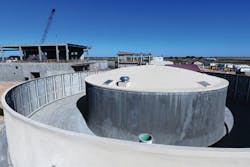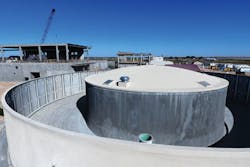In 2012, based on completed master plan and feasibility studies, the City of Lubbock, Texas, and its consulting engineer, Alan Plummer Associates Inc., identified the need to address rapid growth in the northwest quadrant of the city, given that the city’s main wastewater treatment facility was located at its southeast plant across town. The existing interceptor from the northwest part of the city was no longer large enough to handle peak flows, so reducing current and future interceptor loading was critical for preparing for future growth.
The solution was a new plant that could handle 50 percent of the daily flow and 100 percent of peak flow in the northwest part of town. The new plant treatment process was designed for a tight phosphorus limit to reduce algae growth in the receiving water. Membrane bioreactors (MBRs) were selected for the treatment process. While proven to be an effective treatment tool, MBRs require consistent flow to work at peak efficiency. Since the city’s peak wet-weather events exceed the daily maximum flow rate, the required peak flow storage volume exceeds the volume for daily flow equalization.
In conjunction with Preload’s engineering staff, the consulting engineer analyzed variations of tank quantities, sizes, and configurations to determine the most cost-effective method for maximizing MBR performance while providing odor control to the equalization tank. The city and Alan Plummer’s engineers chose to combine two tanks into one “tank in a tank” with an inner equalization basin and outer peak flow reservoir.
The inner tank is a 1.25 MG reservoir used for daily flow equalization. The tank is covered, exhausting to an odor control system. The tank floor includes a series of 84 diffusers comprising a large-bubble mixing system. As inflow initially passes through screening and grit removal, the diffusers keep fine solids from settling while adding minimal dissolved oxygen (to protect the downstream anoxic process). The mixing system was designed to be fully-automated, remotely operated and capable of varying the mixing zone depth in the basin.
The inner tank was specified to be an AWWA D110, Type III Wire-Wound Prestressed Concrete Tank with an inside diameter of 90’ and side water depth of 25’. The dome, installed to prevent gaseous odor release, is Preload’s standard 3” cast-in-place application. The subgrade design called for a 10” structural, sloped floor. Preload installed approximately 37 miles of prestressing wire on twenty-seven 26’-11 1/2“ x 10’-3 1/2“ panels.
The outer 2.75-MG reservoir is designed for peak wet-weather events. Although the outer peak flow storage basin is not covered for odor control, five water cannons are provided for wash-down after the peak flow has subsided.
The outer tank is also an AWWA D110, Type III Wire-Wound Prestressed Concrete Tank wall design with an inside diameter of 165’ and side water depth of 21’- 4 1/2”. Preload installed approximately 76 miles of prestressing wire on forty-eight 22’-5 1/2” x 10’-3 1/2” panels.
While the tank-in-a-tank design has been constructed in other areas of the country, this project represents a milestone for the city of Lubbock as being the first in its system and the first in Alan Plummer’s portfolio. It also represents Preload’s first tank-in-a-tank installation in the state of Texas.
Preload is exhibiting at WEFTEC.17, Booth 6734. For more information, visit preload.com.




